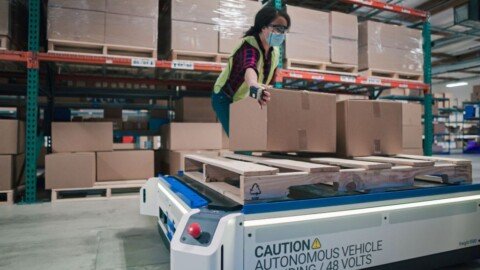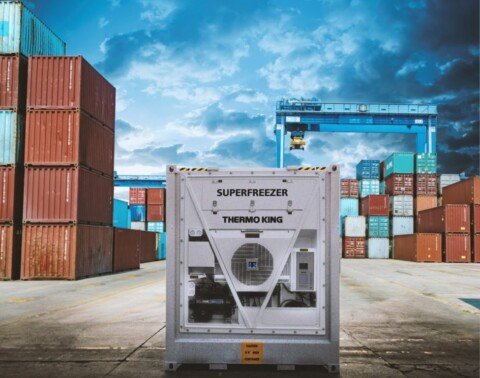Although, the global cargo industry has scaled up its capabilities, collaboration and readiness amidst the COVID-19 gloom, in order to succeed, the global service firms/players need to continue working together as a TEAM in full transparency to ensure integrated, fast, secure and reliable delivery of cargo, concretely. The industry needs to work hand-in-hand and connect with each other to be agile enough and leverage each other’s capabilities, experience and assets to deliver according to market demand and specifications, especially COVID-19 vaccinations, safely and efficiently at scale. Stakeholders should now work towards lifting each other up by enhancing their overall performance, as delivering cargo and time-critical and efficient logistics calls for an absolute teamwork. The time has come, when a collaborative approach can only charter a pathway for growth by adopting new trends and technologies and rescue the industry from this unprecedented crisis. This also holds importance of an overall mix of cargo transport.
CARGOCONNECT
As we look back over the past 19 months, when the COVID-19 pandemic instigated and just began to unfurl around the globe, resulting in the devastating effects on the mankind and the industries alike, the global air cargo industry stayed in the “Spotlight” for the crucial role it played in delivering essential commodities, medical equipment, PPE items, pharmaceutical products, etc. worldwide.
Despite the massive decline in the passenger traffic, especially during the initial 10 months of 2020, the industry witnessed noteworthy trivial growth in the “cargo volumes” partly due to the high demand for e-commerce goods, and a recovering industrial sector, particularly in Asia and the Middle-Eastern countries – serving as a well-known indicator for global air cargo.
According to the Airport Council International (ACI) Annual World Airport Traffic Report (WATR), the initial months of 2020 saw passenger traffic dropped by 63 per cent but the reduction in cargo growth was less dramatic, falling only by 11 per cent. Since then, cargo growth has proven to be resilient in comparison with passenger traffic.
Throughout 2020, the impact of the crisis on the aviation business was so deep and austere that passenger aircraft remained grounded in the deserted airport bays because of 80 per cent reduction in the passenger demand. While cargo demand increased considerably.
However, tight capacity has been looming since the onset of COVID-19. Capacity for ground and ocean cargo was swamped. And that demand for capacity spilled over into air cargo.
Besides consumers’ change in shopping habits, manufacturing was at record levels. The purchasing manager’s index (PMI) came in at a reading of 53.4 in January 2020, up from 51 in December 2019. A reading above 50 indicates a growth trend. This indicates economic growth may run for a while as pent up demand unleashes.
The retrofitting and manufacturing of cargo planes is one example boosting the PMI.
In a report by CNBC published in May, Boeing is converting passenger fleets to cargo jets. Along with building new air cargo planes, Boeing is converting outdated 737 passenger planes for companies like Amazon to meet e-commerce’s growing demand. It is doing the same for Chinese airlines in Shanghai, Guangzhou, and Jinan.
The growth of e-commerce and the general economic recovery are likely long-term trends. Fed by new technologies and new business practices, we can expect long-term growth. And that will further challenge the trend of scarce air cargo capacity.
Therefore, combating all the challenges thrown upon by the ongoing pandemic, the world of air cargo continues to rise to the challenge.
For the first time in the history of aviation, many parked aircraft were brought back into service by converting it into cargo freighters by removing its cabins and passenger seats to enhance the available payload. Air cargo experts say, mobilisation of more than 2,500 parked passenger aircraft for cargo-only operations was the historic and most innovative of all the decisions taken in order to defeat the crisis, followed by automation of internal operations which immensely helped in attaining transparency, resiliency, and efficiency in the value chain.
This digitalisation of operations and business transactions is changing how products are designed, fabricated, used, operated, and serviced post-sale, just as it’s transforming the functional and energy footprint of factories and the management of manufacturing supply chains. This convergence of digital technologies with service industries also promises to recast the landscape of global trade.
No doubt, digitalisation literally rescued the air cargo industry from the severe impact of COVID-19. From giant companies to SMEs and start-ups, the industry stakeholders readily embraced and invested in latest technologies for smart working.
The next key growth driver which chartered the pathway for growth amidst the pandemic is domestic and cross-border e-commerce trade. Following all the COVID-19 protocols, customers preferred purchasing everything online—from groceries to apparel, consumer durables, and even medicinal products.
Even the exports of immunity boosting spices like turmeric and ginger from India saw a considerable hike.
Comprehensiveness and collaboration: Smart, Creative, Effective
The only way global air cargo industry can move forward is through a collaborative approach—by being united, working in unison with each other—towards developing customised delivery models and handing over freight to the final-mile receiver—faster, safely and efficiently. Overall, the approach at this point of time is to lift each other up and work together as a strong force.
Pressured by customer demand, a rising trend toward an omnichannel strategy is afoot. Airlines are seeing a need to look beyond traditional airport-to-airport service. Now, airlines and other stakeholders see opportunities in providing end-to-end services. This trend is particularly taking shape in Europe.
For instance, to optimise delivery, Swiss WorldCargo has partnered with the Swiss Postal Service. In the US, Amazon is expanding its Amazon Air Services and combining it with its ground transport services. Amazon’s goal, like Swiss World’s to provide seamless end-to-end service.
In North America, FEDEX and UPS comprise 80 percent of the air cargo market. Now, Amazon is snapping up air cargo space to meet its needs. That leaves only a small percentage for others to expand into air freight services.
As this trend unfolds, partnerships between airlines and shippers will likely increase. Likewise, shippers and airlines may also increase partnerships with integrators/3PLs.
Experts believe greater collaboration and cooperation can only determine success in these times. Earlier the industry faced challenges such as national lockdowns and border shutdowns; these are now replaced with vaccine distribution followed by consequent recovery of global trade and world economies.
And in order to cope up with the challenges, it’s highly commendable to see industry stakeholders—airlines, airport communities, supply chain partners working more closely together, communication is more open and transparent and greater focus is on the common goal of providing a connected, secure and efficient environment to move freight across and beyond territories.
Abu Dhabi’s The HOPE Consortium is one such example of successful cross-sectoral collaboration.
“Vaccinating the world against COVID-19 is a tremendously complex task, for governments, NGOs, vaccine manufacturers and distributors worldwide. This is an extraordinary crisis and requires a collective effort to help emerge from this crisis in the shortest possible time. The HOPE Consortium is a commitment to the global battle against the COVID-19 pandemic. It was formed with six founding partners— Abu Dhabi’s Department of Health, Etihad Cargo, Abu Dhabi Ports, Rafed, Maqta Gateway and SkyCell. The initiative aims to tackle the various logistical and infrastructural challenges of global vaccine distribution as well as the implementation of appropriate deployment strategies, plans and policies to ensure a complete global distribution of the COVID-19 vaccines,” said the Etihad Cargo spokesperson featured as part of ‘Terrific Together in Connecting Continents’ chapter.
“So far, leveraging its end-to-end supply chain, The HOPE Consortium has delivered over 47 million vaccine doses in 35 countries and isfurther planning to expandits resources to handle the storage and the distribution of 18 billion doses per annum. This has been achieved via a unique and collaborative approach which has linked both the physical and digital supply chain from production to patient,” highlighted the spokesperson.
Air cargo industry analysts like Glyn Hughes, the present Director General of TIACAhad already said, that looking at the current situation, community-based collaboration will be needed more than ever, as the passenger side of the industry will face several challenging years ahead to resume previous levels of global network connectivity and passenger numbers.
“This means the air cargo will continue to operate in a capacity challenging environment, with increased volumes of air cargo demand. Especially, in the area of special cargo which bring enhanced requirements for handling quality, facilities and focus on timelines. Successful airport communities will be those which can anticipate these enhanced demands and have effective response plans in place. Long-term infrastructure investments in specialised facilities also dictate the need for collaborative and open community dialogue,” Hughes mentioned.
“As we have seen with the first few months of COVID-19 vaccine distribution, those airport communities which already had demonstrated expertise in the safe and secure movement of precious cargo, have been the first to which this new cargo has been routed,” he further added.
Lastly, Hughes said, the industry is being encouraged to adopt a local air cargo community approach in executing these specific requirements. “Digitalisation is also a critical enabler, as real-time, accurate information sharing is imperative. This will also enable communities to connect with other communities, creating global networks of trusted partners.”
Disrupting the Cargo of Things marketplace
Amidst the pandemic, air cargo is definitely on the course for growth, but is facing volatility in demand, supply and prices. For the first time, leaving behind the fierce competition, the air cargo industry stakeholders— airlines, airports, ground handling firms, freight forwarders, GSAs, etc. are unanimously working towards achieving a common goal of attaining pre-COVID-19 growth levels, by adopting various competent and reliable strategies, be it making effective use of technology, aircraft conversion, or expanding networks and freighters.
The idea is to support, motivate and encourage each other to perform better, while dealing with demand supply constraints and price hikes.
As long as demand for cargo space exceeds supply, rates will continue to rise. Currently, international travel is 88 per cent below pre-crisis levels. That’s significant because passenger planes transport 60 per cent of all air cargo.
In May this year, IATA reported that more air cargo planes are flying today than in pre-crisis times. In total, 1,100 air cargo planes are operational—240 more planes than in January 2020. Yet, the industry still has a 39 per cent capacity shortage.
To ease capacity constraints, manufacturers are building more cargo planes and retrofitting passenger planes. While helpful, it takes time to manufacture and retrofit planes.
So, stable rates remain elusive for the long-term. As distribution of vaccines shifts to international deliveries, rate volatility will likely persist. Also, the uneven opening of economies should further delay stabilisation of rates.
According to IATA, Asia-Pacific airlines saw demand for international air cargo rise 10.5 per cent in February 2021 compared to the same month in 2019. As the main global manufacturing hub, the region has benefited from the pickup in economic activity. The region’s airlines reported the highest international load factor at 77.4 per cent. While, North American carriers posted a 17.4 per cent increase in international demand in February 2021. Economic activity in the US has been reported to recover, supported by the rising demand for e-commerce amid lockdown restrictions. Similarly, European carriers posted a 4.7 per cent increase in demand in February compared to same month in 2019. Cargo demand was largely unaffected by the new lockdowns in Europe and the operating conditions remain supportive for air cargo.
Middle Eastern carriers also posted an 8.8 per cent rise in the international cargo volumes in February versus February 2019. Of the region’s key international routes, Middle East-Asia and Middle East-North America have provided the most significant support, rising 27 per cent and 17 per cent respectively in February compared to February 2019.
The only region whose carriers recorded decline in cargo activity during 2020-2021 is Latin America. The carriers reported a decline of 20.5 per cent in international cargo volumes in February compared to the 2019 period asthe drivers of air cargo demand in Latin America remain relatively less supportive than in the other regions.
Even African carrier’s cargo demand in February increased a massive 44.2 per cent compared to the same month in 2019, the strongest of all regions. Robust expansion on the Asia-Africa trade lanes contributed to the strong growth.
For example, one of the largest multinational pan-African carriers, Ethiopian Airlines has converted 25 passenger aircraft to “preighters” in addition to the existing freighter fleets to support countries across the globe in their fight against COVID-19.
According tothe Ethiopian Airlines’ spokesperson featured as part of ‘Terrific Together in Connecting Continents’ chapter, the carrier has invested heavily in cargo infrastructure development in terms of warehouse facility, fleet size/mix, as well as cargo expertise development. “During the COVID-19 outbreak, Ethiopian was therefore well-equipped to deal with the new normal,” the official said.
“In general, airlines have learnt a lesson that investing in cargo business is very important, especially in a situation like COVID-19, where passenger operations almost ceased and the aspect of cargo took the lead to rescue airlines from a complete collapse. That said, Ethiopian has rewarded itself from the investments it has made over the years in its cargo infrastructure development, fleet, manpower as well as ICT to successfully navigate through the crisis period. In FY 2019-20, the carrier transported more than 525,374 tonnes cargo, achieving an average of 24.76 per cent growth rate for the past three years,” the official added.
For the near future, the carrier has planned to add more new freighter destinations in order to increase global coverage. The carrier is also planning to add B737-800F and B777-200F freighter aircraft in the coming year.
In fact, since March 2020, Swiss WorldCargo has been transporting goods using its cargo-only passenger aircraft. “In this sense, we have been able to effectively meet the strong demand for cargo during this time period. However, our core offering as a belly cargo carrier—is that we transport goods in the bellies of our aircraft, wherein we are able to supplement our passenger transport efforts. Our capacity both in ‘preighters’ as well as bellies is particularly strong on our intercontinental flights. Our flagship Boeing 777-300ERs as well as our Airbus A340-300s and Airbus A330-300s offer large amounts of cargo space. As already mentioned, we have established ourselves with the focus around transportation of care-intensive, high-value goods, such as valuables, engineering components, and pharmaceuticals,” the senior-level spokesperson from Zurich-based carrier said to CARGOCONNECT.
Meanwhile, the Volga-Dnepr Group spokesperson noted that the group managed to cope with the challenges by adjusting flight schedules, planning charter flight programmes, operating urgent charters to guarantee delivery of much-needed cargo worldwide and assisting the regions and nations in their battle against COVID-19 spread.
“Throughout 2020, our planes were up in the sky delivering much-needed cargo with PPE, vaccine equipment, medical supplies and other cargo aimed at overcoming COVID-19 consequences. We continued to follow market sentiments and customers’ needs and introduced new products within Volga-Dnepr Group, which are long-term regular charter and ACMI programmes, as well as scheduled and charter operations. Of course, we do leave space for free sales (though various channels, including e-bookings), urgent charter options and prioritising healthcare shipments such as vaccines. This product and service range is allowing us to follow our growth strategy and we are confident to achieve pre-COVID-19 volumes soon,” said the official.
Canada’s flag carrier Air Canada is nowhere behind.
As a belly carrier, Air Canada had to pivot rapidly at the start of the pandemic to capitalise on the airline’s passenger fleet for cargo-only flying. That programme kept volumes high in 2020 and the trend has continued in 2021. In fact, in July, the carrier said it marked its 10,000th cargo-only flight, which is a remarkable accomplishment given that the first such flight was launched in March 2020.
“The cargo-only flights allowed us to put scheduled flights on routes where passenger flights were grounded, and to add capacity on routes where passenger flying continued (for example: London, Paris, Frankfurt),” said the carrier’s spokesperson while speaking to CARGOCONNECT.
“As for post-pandemic growth, our focus for the rest of 2021 is adapting to cargo-only flying and ramping up operations for the integration of our first Boeing 767 freighter arriving in the ‘Fall’ 2021. The programme is key to our post-pandemic strategy, as it will enable us to provide consistent capacity in markets where there is fluctuations in terms of passenger operations. It will allow us to sell main-deck capacity and feed our widebody passenger belly routes,” the senior-level official informed.
“Our pivot to cargo-only flying was one of many steps the leadership team took in an effort to limp through the challenging times. As the world reopens and passenger activity begins to resume, the biggest untapped opportunity lies ‘within the talent we have at this great airline to ensure we continue to foster and encourage the environment’, embracing the creative culture and driving change by thinking beyond the norms to solve problems. We have so many great examples of employees jumping in and finding new ways to run the business better. Therefore, it is our duty to continue to empower and support the entrepreneurial spirit that has helped us get through the worst of 2020,” he expressed.
For the largest European carrier Lufthansa Cargo, preighters are a special solution in special times. They are especially helpful when a large amount of medical protection equipment, such as masks need to be transported around the globe fast. Due to its light weight, such cargo can be transported in the passenger cabin very well.
According to the Lufthansa Cargo spokesperson featured as part of ‘Terrific Together in Connecting Continents’ chapter, the carrier is planning to expand its freighters to 15 long-haul freighters and two converted freighters on continental routes across Europe that complement the bellies of its passenger airlines— Lufthansa Airlines, Austrian Airlines, Brussels Airlines, Eurowings Discover, and SunExpress.
Most importantly, access to space-efficient and secure shipment solutions is absolutely vital, and for that Envirotainer has launched an industry-latest and most innovative container solution—the Releye® RLP, as the company is currently seeing an increased demand both for regular temperature-sensitive shipments as well as for the COVID-19 vaccine shipments.
“As the market leader in secure cold chain solutions for air transportation of pharmaceuticals, we have already facilitated transportation of more than 250 million doses of COVID-19 vaccines. But we are not stopping there; we have increased production of our RKN e1 and RAP e2 containers. We also recently launched the Releye® RLP temperature-controlled container that we believe will revolutionise the market. It is stronger, safer, better for the environment and more connected than all other competing solutions combined—with fully integrated live monitoring, and a unique airflow technology for maximum temperature stability in the cargo bay,” the spokesperson from Envirotainer highlighted.
“Our objective is to help our customers deliver life-saving medicines to the right people, in the right time and in the right condition. We are working with all our partners and customers to make the solution available so that they can benefit from the increase in available capacity, performance and functionality,” the official added.
Cargo and ground handling firms are also leaving no stone unturned and working 24×7 to ensure highly efficient cargo handling and transportation operations.
Turkey-headquartered Çelebi Aviation,one of the largest independent ground handling companies in India and present since a decade now, carrying out ground handling operations at seven major airports of the country, including Mumbai, Delhi, Bengaluru, Hyderabad, Kochi, Ahmedabad and Kannur, tackled the plethora of challenges brought in by the pandemic and now geared up to capture additional opportunities with India Inc scaling up the largest ongoing vaccination drive.
“I feel it’s all in understanding the kind of opportunities that exists, how the business can be expanded, how the sector could be made attractive for both domestic and international players. Once the economies of scale come into play, players would be more interested to step into this sector as it has the potential to grow and develop into a decent preposition,” the top-level official said to CARGOCONNECT.
“We foresaw the need to adopt GDPR compliance norms in India and initiated measures towards it to ensure that we were safeguarding not just ourselves but also looking at the needs of our European customers where such compliance is the norm. While we drove a host of enhancements on our core cargo management software, the focus was on improving the efficiency of our operations without halting projects. As such, we will try to do more things which are intelligent and systems-driven and more automised.”
“As Çelebi looks forward to 2022 and beyond, we continue to push the boundaries of technology initiatives like automated storage and retrieval system (AS/RS) for cargo handling and management, evaluating the use of autonomous vehicles, pursuing accelerated digitisation as the standard while leveraging intelligent technologies like Blockchain, AI and IoT as the blueprint for survival,” he said.
The BEST FOOT forward
The supply chain industry is transforming, and so is air cargo. And, emerging trends will reshape the air cargo industry from its pre-pandemic operations.
Some of these trends will take effect before others. But what’s notable is that these trends will have lasting effects. That is, they will change best business practices as well as technologies. That should result in improved operational effectiveness and efficiency.
As the global cargo industry transforms, supply chains must transform with it.
Airlines are starting to devote more space to COVID vaccine shipments. As immunisation levels rise, more vaccines are being designated for less developed countries. Seabury Consulting forecasts vaccine shipments moving by air will peak in mid-to-late summer.
Therefore looking ahead, we can see the entire logistics and cargo handling industry accomplishing the task of distributing COVID-19 vaccines worldwide—as it undoubtedly has to be the foremost priority at the moment.







